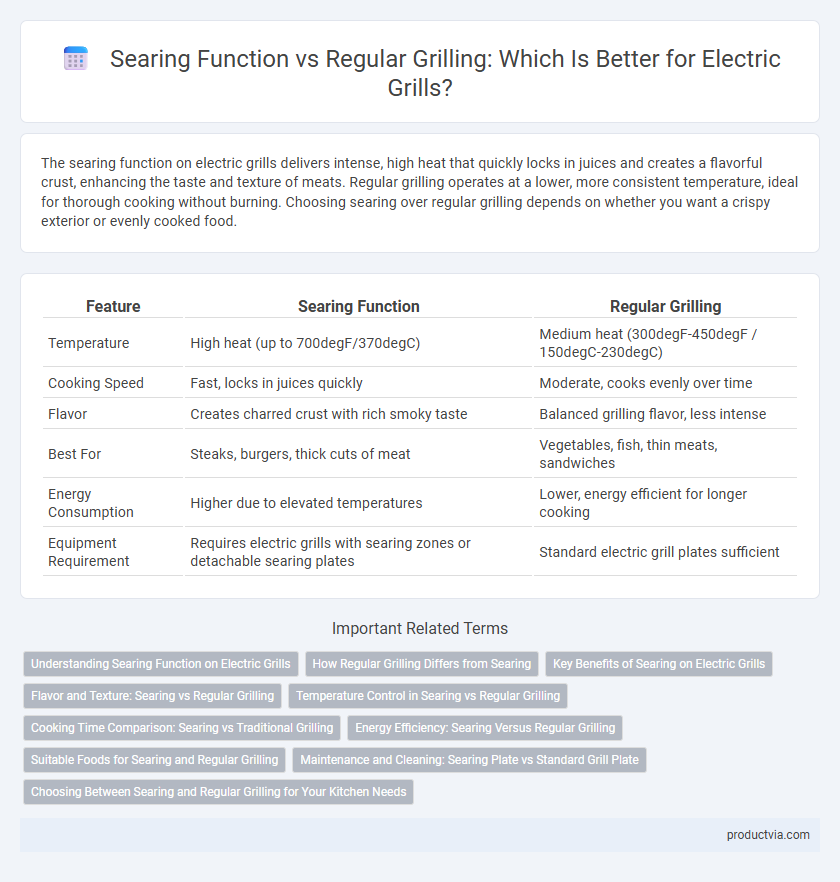The searing function on electric grills delivers intense, high heat that quickly locks in juices and creates a flavorful crust, enhancing the taste and texture of meats. Regular grilling operates at a lower, more consistent temperature, ideal for thorough cooking without burning. Choosing searing over regular grilling depends on whether you want a crispy exterior or evenly cooked food.
Table of Comparison
| Feature | Searing Function | Regular Grilling |
|---|---|---|
| Temperature | High heat (up to 700degF/370degC) | Medium heat (300degF-450degF / 150degC-230degC) |
| Cooking Speed | Fast, locks in juices quickly | Moderate, cooks evenly over time |
| Flavor | Creates charred crust with rich smoky taste | Balanced grilling flavor, less intense |
| Best For | Steaks, burgers, thick cuts of meat | Vegetables, fish, thin meats, sandwiches |
| Energy Consumption | Higher due to elevated temperatures | Lower, energy efficient for longer cooking |
| Equipment Requirement | Requires electric grills with searing zones or detachable searing plates | Standard electric grill plates sufficient |
Understanding Searing Function on Electric Grills
The searing function on electric grills uses high, concentrated heat to quickly caramelize the surface of the food, creating a flavorful crust while locking in juices. Unlike regular grilling, which cooks food more evenly at moderate temperatures, searing targets intense heat zones ideal for steaks and burgers to enhance texture and taste. This function optimizes Maillard reaction outcomes, improving the overall flavor profile and appearance of grilled items.
How Regular Grilling Differs from Searing
Regular grilling on electric grills relies on moderate, consistent heat to cook food evenly over time, ensuring thorough cooking with a tender interior. Searing uses intense, high heat for a short duration to create a caramelized crust and enhance flavor through the Maillard reaction. Unlike searing, regular grilling focuses on gradual heat penetration rather than rapid surface browning, resulting in different textures and taste profiles.
Key Benefits of Searing on Electric Grills
Searing on electric grills locks in juices and enhances flavor by creating a caramelized crust through high heat, which regular grilling often lacks due to lower temperature control. This process improves texture and appearance, producing restaurant-quality browning and Maillard reaction benefits. Electric grills with searing functions offer precise temperature management, ensuring consistent results and reducing cooking time compared to conventional electric grilling.
Flavor and Texture: Searing vs Regular Grilling
Searing on an electric grill creates a caramelized crust through the Maillard reaction, intensifying flavor and locking in juices for a tender interior. Regular grilling cooks food at a gentler heat, resulting in a more evenly cooked texture but less pronounced browning and flavor complexity. The searing function enhances both flavor and texture by combining high heat with quick cooking, making it ideal for steaks and thicker cuts.
Temperature Control in Searing vs Regular Grilling
Searing on electric grills requires precise high-temperature control, often reaching 450degF to 500degF to create a caramelized crust quickly. Regular grilling typically operates at lower temperatures, around 300degF to 400degF, allowing for more even cooking without burning the exterior. Advanced electric grills use adjustable thermostats and infrared technology to maintain consistent temperatures for optimal searing or standard grilling.
Cooking Time Comparison: Searing vs Traditional Grilling
Searing on an electric grill uses intense, high heat typically above 450degF, drastically reducing cooking time by quickly creating a flavorful crust and locking in juices. Traditional grilling operates at lower temperatures around 350-400degF, requiring longer cook times to evenly cook food through. The searing function offers a faster method ideal for thick cuts, while regular grilling provides gradual heat better suited for delicate items needing thorough, even cooking.
Energy Efficiency: Searing Versus Regular Grilling
Searing function in electric grills rapidly raises the surface temperature to create a caramelized crust, optimizing heat usage and reducing overall cooking time compared to regular grilling. This high-heat method concentrates energy on a small area, resulting in less electricity consumption per cook cycle. Regular grilling maintains moderate, consistent temperatures over a longer duration, typically using more energy to achieve even cooking throughout the food.
Suitable Foods for Searing and Regular Grilling
Searing on electric grills is ideal for thick cuts of meat such as steaks and pork chops, as the high heat quickly caramelizes the surface, locking in juices and enhancing flavor. Regular grilling suits a wider variety of foods including vegetables, fish, and thinner meats like chicken breasts, where moderate heat ensures even cooking without burning. Understanding these temperature zones helps optimize texture and taste for each type of food on electric grills.
Maintenance and Cleaning: Searing Plate vs Standard Grill Plate
Searing function plates on electric grills typically feature a smooth, non-stick surface that reduces food residue buildup, making maintenance and cleaning more efficient compared to regular grill plates. Standard grill plates, with their ridged design, tend to trap grease and charred bits, requiring more thorough scrubbing and longer cleaning times. Choosing an electric grill with a removable and dishwasher-safe searing plate can significantly simplify upkeep and prolong the appliance's lifespan.
Choosing Between Searing and Regular Grilling for Your Kitchen Needs
Searing on an electric grill uses high temperatures to create a caramelized crust, enhancing flavor and texture, ideal for steaks and thick cuts. Regular grilling operates at moderate heat, allowing even cooking suitable for vegetables, poultry, and delicate foods. Selecting between searing and regular grilling depends on your kitchen needs for precision cooking versus versatile meal preparation.
Searing function vs Regular grilling for electric grills Infographic

 productvia.com
productvia.com